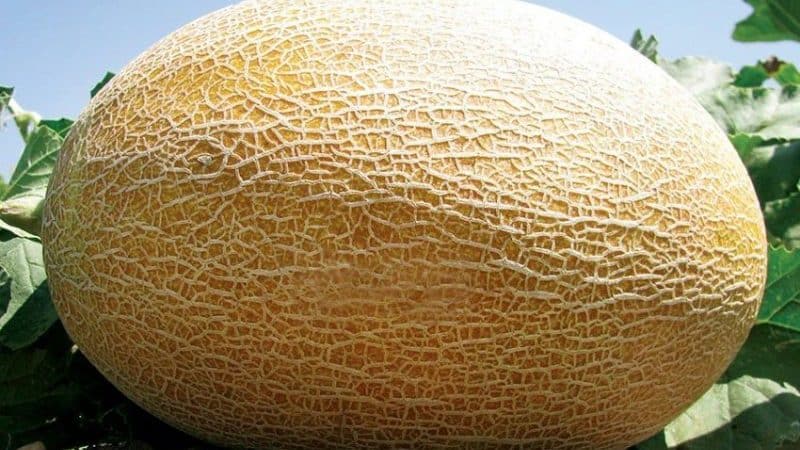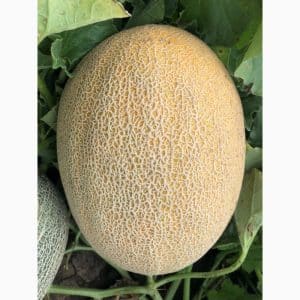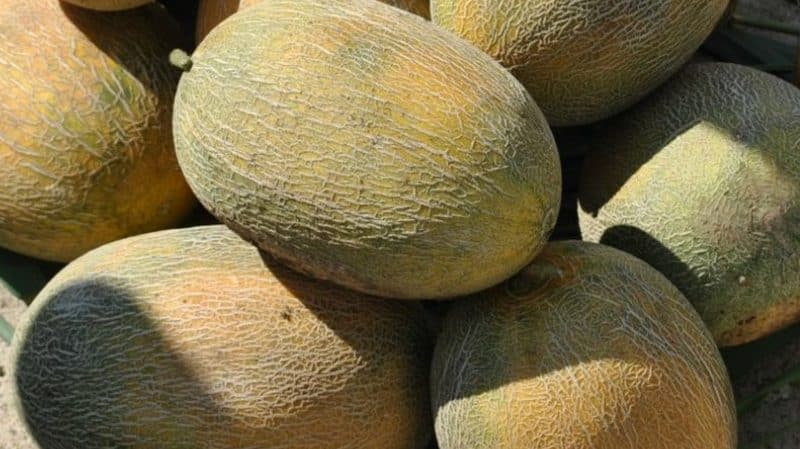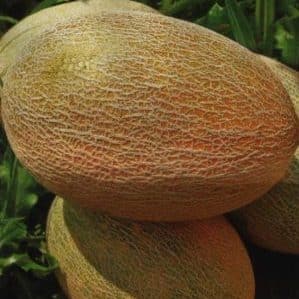The Amal melon hybrid, beloved by summer residents, tastes great and is resistant to diseases
Melon Amal f1 is a hybrid, bred by French breeders. Thanks to its outstanding taste, the culture has gained popularity in Russia and the CIS countries. Melons are distinguished by their attractive presentation and stable yield.
In this article we will look in detail at what a hybrid is and how to grow a rich harvest on your site.
Description of melon
Ripens melon 60-70 days from the moment the first shoots appear. It is recommended to grow Amal in central Russia, planting the crop in seedlings.
Distinctive features
The plant spreads along the ground, the vines are long, the root system is powerful and developed. The hybrid has a strong immunity to diseases and pests, but it is demanding in care and growing conditions.
Fruit characteristics and yield
The fruits have an elongated oval shape. The color is honey-yellow, the peel is dense, due to which the fruits have a long shelf life. Weight varies from 2 to 4 kg.
The pulp is creamy, juicy and sweet, with a strong aroma. From 1 sq. m summer residents harvest from 7 to 13 kg of crop.

How to grow this variety yourself
Amal is grown in greenhouses or in open ground. Seedlings are prepared at the end of March and planted on the site in mid-May.
Preparing and growing seedlings
Seedlings require a container. Plastic boxes with drainage holes and a tray are suitable. Pour soil into the container, make grooves 1 cm deep. Place 2-3 seeds in each, sprinkle with soil and water with warm water.Place the container in a warm and bright place.
Important! Before planting, seeds are disinfected. The material is soaked in a solution of potassium permanganate or Bordeaux mixture for half an hour. Then take it out and dry it on a clean towel. It is recommended to disinfect the soil for seedlings - place it in the freezer for a day. Low temperatures will destroy dangerous fungi, bacteria and insect larvae.
Caring for seedlings consists of timely watering and fertilizing. Water the seedlings once every 5 days. It is important to prevent the soil from becoming waterlogged, as this will lead to the development of fungus and infections. For fertilizer, liquid organic matter and mineral complexes are used - chicken manure, superphosphate, yeast, nettle infusion. Fertilize once every 15 days.
Growing in stages and care
Amal is planted on soils with low acidity. The lands should be located in a sunny and windless place. To be safe, before planting, lime the soil by adding a mixture of dry lime and wood ash. This composition reduces acidity and makes the soil more nutritious for plant development. The distance between the grooves is at least 70 cm; seedlings are placed in each groove, sprinkled with earth around them, and watered.
Productivity depends on the regime of watering and fertilizing. Water the plant with warm water in the morning or evening. The stream is directed under the root; water should not fall on the stem or leaves. The interval between watering is 5-7 days.
Twice during the growing period, instead of water, use an infusion of nettle or ash.. This strengthens the plant’s immunity, develops roots and stems. Two weeks before harvest, watering is stopped.
For feeding, alternate organic matter and minerals.The development of fruits is favorably influenced by the mineral complexes “Zdraven”, “Magic Leyka”, as well as ash, ammonium nitrate, urea, manure, and humus. During the growing period, Amal is fed 3-4 times. For better absorption, fertilizers are applied before watering.
Features of cultivation and possible difficulties
Melon beds need regular weeding. The soil is loosened once a week, the procedure feeds the roots with oxygen, the soil becomes lighter. The depth of loosening is no more than 5 cm. Along with loosening, weeds are removed - bindweed, burdock, nettle. They block the light and prevent the plant from developing normally. Hoes and rakes are used for weeding.
Important! To get a rich harvest, pinch the plant and leave one main stem and 2-3 side ones, the remaining shoots are removed. If the procedure is not carried out in time, many small fruits will form. There is not enough strength for everyone to develop. If the fruits are ripe and large, then a support is built for them from stone or wood. Melons should not lie on the ground, as this will lead to rotting.
For healthy plant development, monitor the amount of mineral fertilizers applied. An excess of phosphorus or nitrogen causes the bushes to wilt, so it is recommended to record the date and amount of fertilizing. To avoid negative consequences, alternate mineral fertilizers with organic ones.
Diseases and pests
Melon is planted in one place for no more than two years in a row. The best predecessors for a hybrid are cabbage, greens, and legumes.
Due to high humidity and improper care, the hybrid becomes ill with viral and infectious diseases, and pests appear. Diseases also occur due to non-compliance with crop rotation rules.
- Powdery mildew appears as a white coating on leaves and stems. The cause of infection is humidity, non-compliance with crop rotation rules, contaminated soil. For prevention, the bushes are sprayed with whey; for treatment, “Quadris” preparations or a solution of copper sulfate are used.
- Root rot appears in beds with weeds, occurs in rainy and hot summers. The base of the stem becomes covered with a gray coating, the plant withers, and the fruits become deformed. For treatment, the beds are sprinkled with dry ash.
- melon aphid occurs in beds closer to the fruiting period. Midges are attracted by the sweet aroma of the fruits; insects gather on the leaves and feed on the juice. For treatment, spraying with iodine or herbal infusion is used.
- Spider mite It affects both young plants and mature bushes. The pest envelops the stems and leaves in a web, taking vitamins from the melon for development. They get rid of spider mites using the Iskra product, and use Bordeaux mixture for prevention.
Harvesting and application
Harvest as needed maturation. A ripe melon acquires an attractive yellow color, the peel becomes hard and dense. The fruit gives off a pleasant sweetness smell, the stalk dries up.
If there is a strongly pronounced mesh on the surface of the melon, then it is used as food immediately or processed. If the network is weakly expressed, this crop is suitable for longer storage. To do this, wipe the melons with a dry cloth and put them in a dry basement or cellar.
Melons make delicious snacks: jam, jams, fruit baskets. The pulp is sweet and aromatic, harmoniously combines with honey, lemon, banana, mint. Cocktails, smoothies and compotes are prepared from melon.
Interesting! Use melon cubes to make seafood salad. To do this, take shrimp, basil, black pepper and wine vinegar. The result is a spicy and original dish.

Advantages and disadvantages of the variety
Among the disadvantages, note the hybrid’s demanding conditions of light and heat, care and fertilizing. It will be possible to obtain a rich harvest only if all agrotechnical rules are observed..
The advantages of the variety include:
- productivity;
- taste;
- commercial qualities;
- keeping quality;
- versatility in use.
Reviews
Hybrid Amal is known among gardeners around the world. Here are a few reviews from Russian summer residents about the harvest:
Polina, Moscow: «Melons grow juicy and fragrant. I plant it using seedlings and the yield is stable. Last season I collected 7 large and heavy fruits from the garden. I recommend for landing."
Alexander, Orel: “I love melons, especially large ones. I like Amal; it doesn’t require much attention to care for. I recommend planting according to the 50x70 sowing pattern. The leaves of the plants are wide and require free space.”
Ekaterina, Sochi: “I planted Amal last year. The harvest disappointed me. The melons suffered from root rot and did not develop well. I think the reason is the acidic soil.”
Conclusion
The Amal hybrid is distinguished by its taste and aroma - gardeners prepare sweet dishes and desserts from it. The plant is demanding on soil conditions and care. Amal is planted on loose and fertile lands, carefully monitoring the regime of irrigation and applied fertilizers.
Harvest in August, when the fruits become large and acquire a yellow-honey color. Some are consumed fresh, some are stored for 1-2 months.